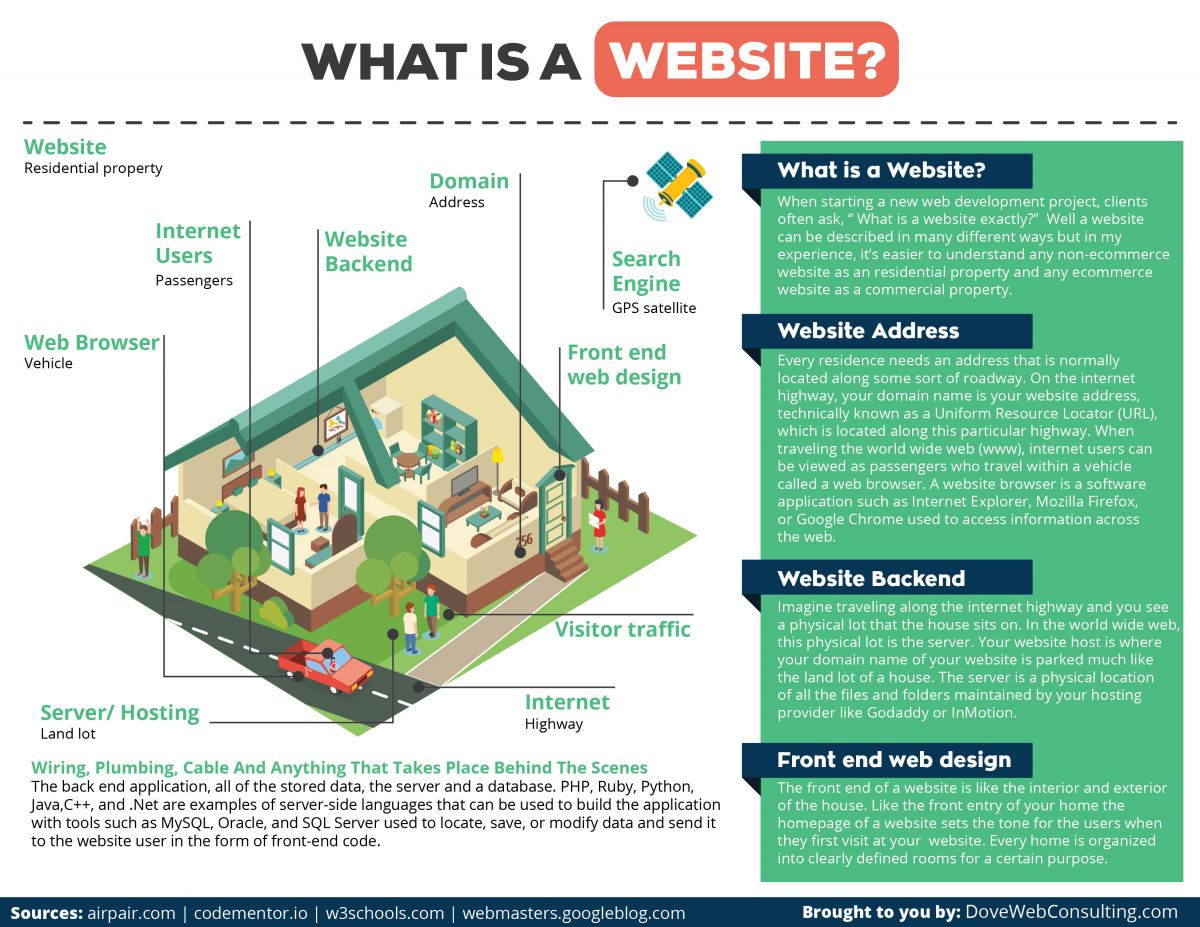Spring Hill KS, 66083
- Home
- > Blog Main Page
- > Websites
- > Creating a Modern eCommerce Website
Creating a Modern eCommerce Website

In the early days of eCommerce web design, a perfectly-matched domain name (such as shoes.com or toys.com) used o be an essential factor in the website's success. But the extraordinary success of eCommerce giants like eBay and Amazon proves that what a website sells doesn't necessarily need to be tied to its domain name.
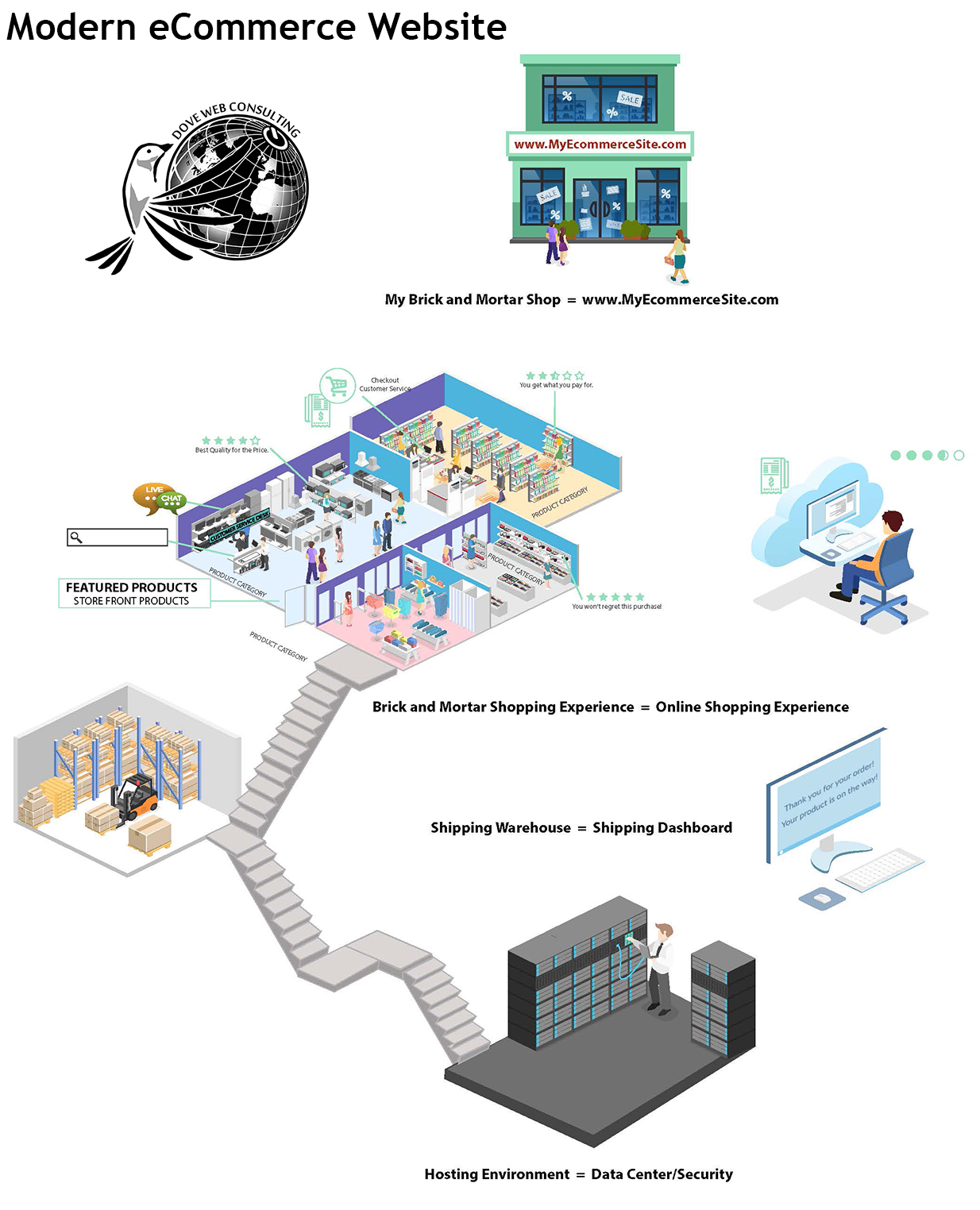
Successful modern eCommerce websites require a plan and must function as efficiently as possible. In many ways, an eCommerce website must work like a brick-and-mortar store with a strategically placed, a visually-appealing merchant rack, or well-organized stock room. The features that drive sales on an eCommerce website must be just as strategic. So how do you make your eCommerce website perform in a way that will make it successful?
Whether purchasing an item in a brick-and-mortar store or online, organize the transaction process. You take your new item to the checkout counter with cash or debit/credit card in a brick-and-mortar store. After completing a payment transaction with the cashier, you exit the store with your new purchase hand. The noteworthy difference with online purchases is that you won’t handle or see your item until it has arrived at your shipping address.
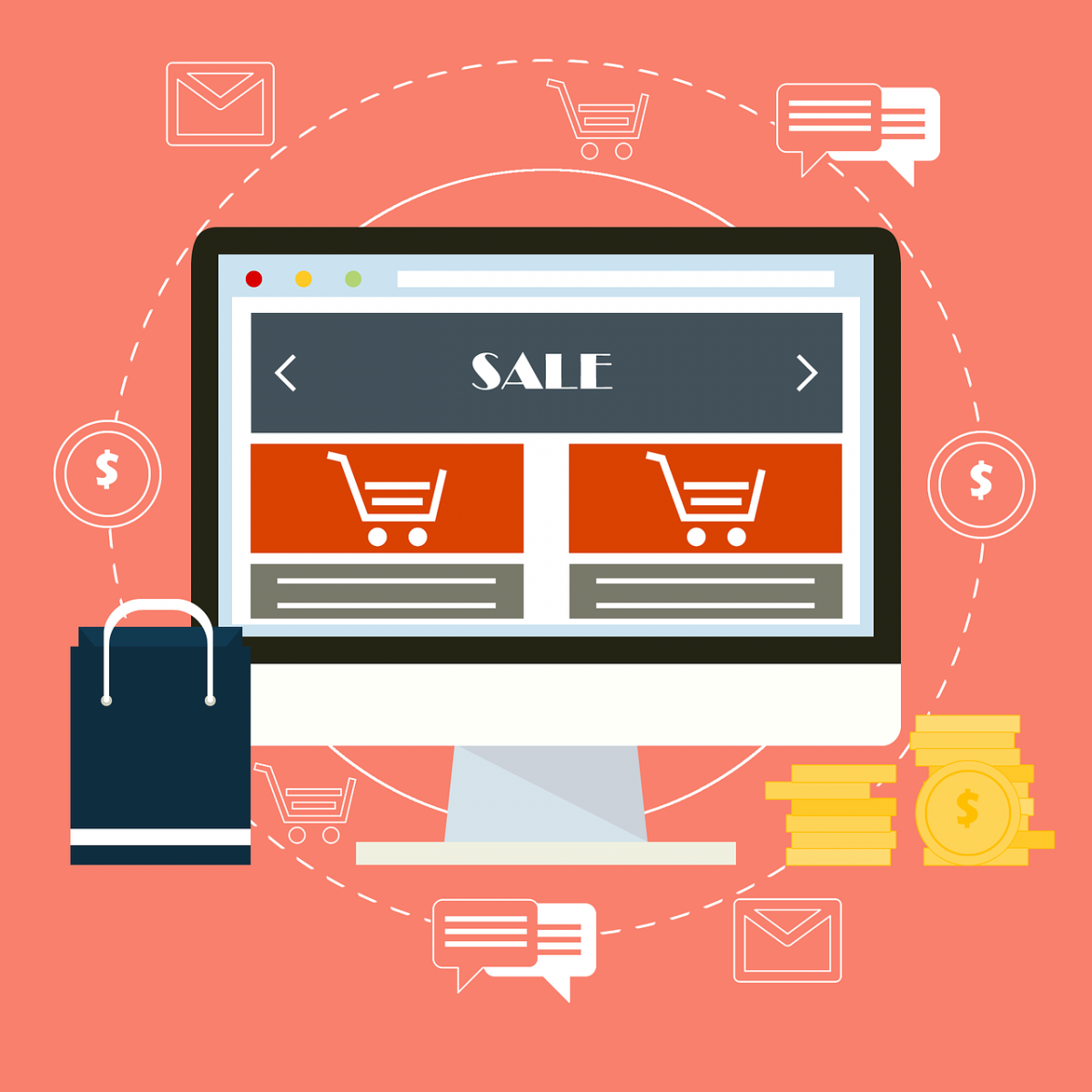
So What is eCommerce Exactly?
In the September-October 2017 issue of the International Journal of Advanced Research in Computer Science, Computer Engineering Professor Prathamesh Churi defines eCommerce as “electronic commerce” that “caters to trading goods and services through the electronic medium such as the internet, mobile or any other computer network.” In other words, eCommerce is the buying and selling of goods on the internet.
eCommerce Basics
When a website is accessed, a request passes to the webserver of MyWebsiteSite.com's host. Typically, the webserver houses the files within a website's database. Programming languages determine what’s present, and the server sends the information back to the browser.
When an eCommerce website is accessed, a request passes to the MyEcommerceSite.com host's webserver. However, a web server for an eCommerce website manages the online storefront and can process transactions. An eCommerce database is more robust than a non-eCommerce website because it can record and track stock items and update its database as users make purchases. Ideally, this database should send alerts or notifications to the seller that supplies of low-stock items must be ordered. Finally, a dispatch system should connect to the online warehouse for instant identification and rapid shipping to the customer.
To manage and develop the content stored on these files, known as a content management system (CMS). If you’re not a web developer but want to create an eCommerce store, the easiest way to accomplish this goal is to use a content management system (CMS). A content management system for an eCommerce website is also known as an eCommerce Platform.
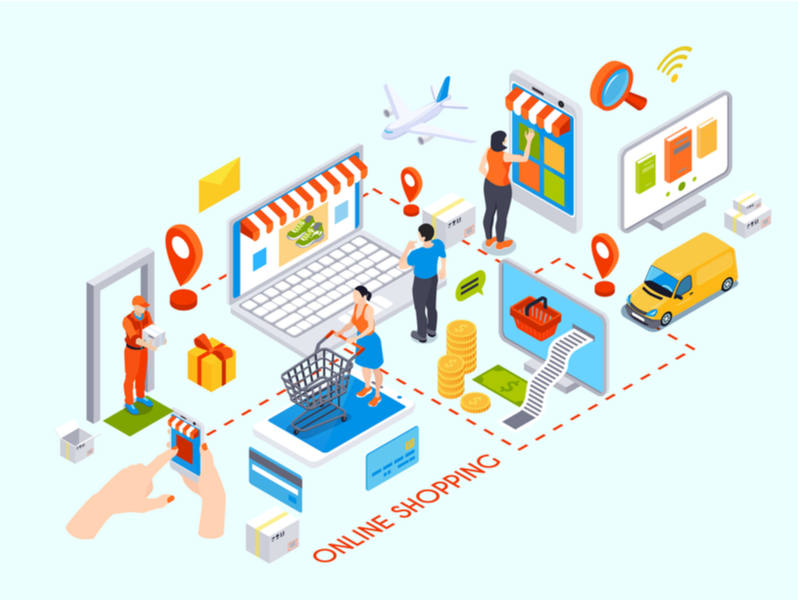
Issues to Consider when Creating an eCommerce Website
There are many types of eCommerce websites, i.e., Business-to-Business (B2B), music portals, auction websites, and financial management websites. This discussion will be limited to eCommerce retail selling for simplicity. Here are the primary issues and design elements to consider as you create your eCommerce website:
1. Visual Appearance
As any website owner knows, visuals are essential. They can make or break a website and are significant for eCommerce sites. According to research by 3M, memory improves by 400% with visual aids, and all humans process visual information 60,000 times faster than text alone.
The conversion optimization platform Justuno notes that the most crucial factor in the purchasing decisions of 93% of online consumers is (drum roll, please) visual appearance! For eCommerce websites, visuals relate to every graphic design element featured on your websites, including a color scheme that compliments your products and high-quality product photos.
So, what makes an excellent visual appearance? Bright colors, white space, and design inspiration are crucial elements. Of course, every website is different, so finding the right design features is critical. But if you keep these things in mind, you're sure to create a visually appealing website that will convert visitors into customers.
2. Cost
All eCommerce platforms come with a price. Whether a flat monthly fee, you must consider all costs in your business model. At the very least, think about the transaction fees, the maximum number of products you can sell, loyalty programs, gift cards, and the ability to create free shipping.
3. Ease of Use
Strongly consider how you’re going to manage your eCommerce business. The website interface needs to work smoothly if your eCommerce platform's goal is to sell products to consumers. A practical, meaningful, and valuable user experience is one of the most critical conversion factors from the home page to the checkout page. Focus your efforts on creating an enjoyable online shopping experience
4. Payment Gateway
A good payment gateway with standard features like guest or customer login, a straightforward checkout process, and dynamic payment options such as using PayPal, a credit card, or a bank account is critical to a successful eCommerce website
5. Security
Security is an essential part of eCommerce. If your website accepts credit cards, you should have an SSL certificate (HTTPS://) on your checkout page. To help build trust with your customers, install the SSL throughout your site and BEFORE you start developing the website to prevent mixed content issues
6. Hosting
Hosting must be fast and reliable. Note that except for Magento, most open-source platforms usually require self-hosting. The alternative eCommerce platforms that come at a monthly cost are usually SaaS-based (Software-as-Service) and provide their hosting
Before diving into website design, product categories, and online presence, do your homework: research eCommerce platforms. By understanding the features and functionality of each platform, business owners can create an engaging and interactive online presence for their product categories. Utilize support teams and user communities to ask questions and get started on the right foot.
Before signing up for a platform, precisely understand the terms of service and what your business requires. This level of due diligence will pay off in the long run by preventing headaches, frustration, and lost time. So take a deep breath, power through some additional research, and set your business up for success.
When launching an eCommerce site, there's a lot to consider. First and foremost among those considerations should be the platform you choose to power your online store. There are many great options, but not all will be equally well-suited to your particular product categories or business needs.
That's why it's essential to do your homework before committing to a platform. Reach out to support teams, user communities, and business owners who have already established an online presence. Ask them questions about the features and functionality that your business requires. And be sure to carefully consider all the SEO features each platform offers. Only then will you be able to choose the best option for your eCommerce website design project.
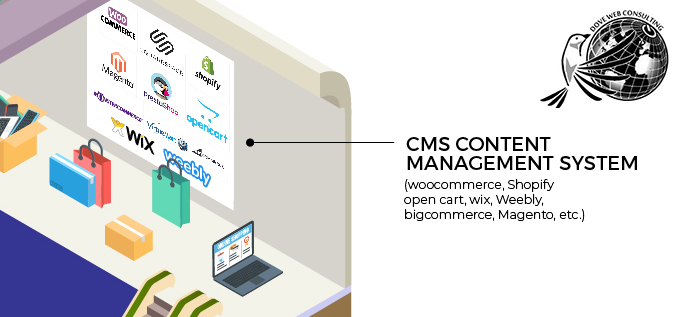
Which eCommerce Platform is Right for My Business?
One of the most critical decisions you’ll need to consider as you develop your eCommerce site involves which eCommerce platform best suits you and your business. An eCommerce platform has many functions: it’s not only similar to a brick-and-mortar company’s storefront, but it also provides the software necessary for your customers to purchase your products and services and for you, the owner, to manage the operations of your online store.
There are hundreds of eCommerce platforms, and each of them offers different features and functions that may or may not be suitable for your business. Here are some of the most popular eCommerce platforms available:
- WooCommerce is an e-commerce plugin for WordPress, the world’s most used content management system. WooCommerce is the world’s most popular e-commerce solution among its competitors. It’s written in PHP, free to use, and known as the most customizable platform for eCommerce out on the market today. So WooCommerce security should be your #1 priority.
- Squarespace is a Software as a Service (SaaS) eCommerce platform. If you’re looking for a simple site with only a couple of products to sell, you may consider Squarespace. Suppose you're looking to sell across multiple channels like Amazon or eBay. In that case, you should look elsewhere with robust marketing and functionality.
- Shopify is another SaaS that’s and features an open-source template programming language called liquid written in Ruby. Even with a liquid developer, the front-end language is primarily PHP based. So it would not hurt to look for a liquid developer with a programming background in PHP. However, Shopify's designed to allow anyone to quickly sell products online. To make significant customizations over time, you’ll have to hire a web developer with liquid programming skills.
- WixStores is a cloud-based SaaS that features drag-and-drop template editing, making setting up your eCommerce store easy. But note that once you’ve chosen your template, you can’t change it later. In other words, you’ll have to rebuild your content if you’d like to start with another template. Multi-channel selling is also limited.
- Magento has two unique platforms: Magento Open Source is a free, open-source eCommerce platform. Magento Commerce has an on-premises or platform-as-a-service version that’s not free. Still, it has much more flexibility and support than the free version. What’s impressive about Magento is that it can support up to 500,000 products and thousands of transactions per hour. However, the license fee starts at $18,000 annually to get performance updates, additional flexibility, and support.
- MonsterCommerce was acquired by the technology company and a subsidiary of Web.com, Network Solutions, in 2006. Among Network Solutions' eCommerce plans, only the Premium plan offers bulk management. However, there is a special note regarding the company’s current plans:
- “Limited time offer of $7.95 on Starter, $9.95 on Standard, and $19.95 on Premium packages. Promotional pricing applies only to the first billing cycle. The Starter's current rate is $29.95 per billing cycle. Standard is $54.95 per billing cycle, and Premium is $99.95 per billing cycle. Customers on a monthly billing cycle receive a bill every four weeks. Transaction fees and set-up fees may apply. Offer is good for new purchases only with any monthly term. It cannot be combined with any other offer. Discount applied in [the] shopping cart.”
- PrestaShop is another free, open-source eCommerce platform written in PHP that can support companies that offer several thousand products. However, SEO optimization has been noted as an issue, and unlike WooCommerce, the number of templates and plugins is limited.
- Weebly eCommerce is an all-inclusive drag-n-drop builder marketed towards creatives and small businesses with zero experience or interest in web development. The platform is suitable for companies focused on lead generation or is informational but interested in selling just a few products. It does not integrate with Amazon, eBay, Google Shopping, or the social media platform Facebook for two-way sync. It’s important to note that you must pay for the highest plan to have PaPal as a payment option.
- OpenCart is yet another open-source eCommerce platform written in PHP. Their website states that the OpenCart marketplace offers over 13,000 themes and modules to start and scale one’s business at the time of this writing. Updating to a newer platform version can be challenging without developer documentation, and community support is also limited compared to WooCommerce.
VirtueMart is an open-source eCommerce technology written in PHP and developed as an extension of the CMS Joomla. Joomla has lost its popularity recently to WordPress, so VirtueMart has experienced an equal drop in popularity. So it would be best if you had Joomla use VirtueMart.
BigCommerce is an all-inclusive SaaS eCommerce platform marketed toward established and growing online companies looking for a user-friendly solution. At first glance, the pricing seems fair, especially since there are no transaction fees for any plans. However, if your online website earns more than $50k per year in sales, you must choose the Plus Plan at $50 per month. Also, suppose you're looking for advanced options such as priority support, advanced filtering options, and the ability to host a sagging environment for development. In that case, you could easily be spending up to $500 a month.
So What’s the Secret to a Successful eCommerce Website?
What are the key elements of a successful eCommerce website? To answer this question, we need to put ourselves in the shoes of our potential customers. What do they want to see when they visit our site?
First and foremost, they want a clean design that is easy to navigate. They also want to see strong calls to action encouraging them to purchase from our brand. Additionally, they want to be able to quickly find the products they are looking for in organized categories. Remember, they want to see beautiful product images that make them want to buy from our brand.
The user interface (UI) and user experience (UX) must be well-designed and highly intuitive. Additionally, product photography must be top-notch, which often encourages a purchase. They also want to see social proof through reviews and testimonials from other happy customers. Finally, we must ensure that our eCommerce website is tailored to our target audience.
To create a successful eCommerce website, we must consider all these potential customer needs. By including all the critical elements listed above, we can create a website that will drive customers to purchase repeatedly. Catering our content and design specifically to our target audience will allow us to create an online space that is both engaging and effective. We can create a virtual space that sells with vital visual elements and clear messaging.
Sources:
- BigCommerce. bigcommerce.com Accessed 9 May 2018.
- Churi, Prof. Prathamesh. “E-Commerce Security With Secure Electronic Transaction Protocol : A Survey And Implementation.” International Journal of Advanced Research in Computer Science, vol. 8, no. 8, 2017, pp. 5–9., doi:10.26483/ijarcs.v8i8.4567.
- Datanyze. “E-Commerce Platforms.” E-Commerce Platforms Market Share Report, datanyze.com/market-share/e-commerce-platforms. Accessed 8 May 2018.
- DeMatas, Darren “E-Commerce Platforms.” Ecommerce Reviews, selfstartr.com/category/ecommerce-reviews.. Accessed 9 May 2018.
- GetApp. “Website and eCommerce Software.” getapp.com/website-ecommerce-software. Accessed 9 May 2018.
- Google search trends and statistics for 2022 (no date) InternetAdvisor.com. Available at: internetadvisor.com/google-search-trends-and-statistics. Accessed: December 6, 2022.
- Josep. “Standard, Plus, Pro & Enterprise: A close look at BigCommerce’s prices.” ToolTester Network. 20 April 2017. websitetooltester.com/en/reviews/bigcommerce/bigcommerce-pricing. Accessed 9 May 2018.
- Magento. magento.com/products Accessed 9 May 2018.
- McKinnion, Jenni. “The Top eCommerce Platforms for 2018 Compared.” Pagely, Inc. 2 January 2018. datanyze.com/market-share/e-commerce-platforms. Accessed 9 May 2018.
- NetworkSolutions. networksolutions.com/e-commerce/shopping-cart-benefits.jsp Accessed 9 May 2018.
- OpenCart. OpenCart.com Accessed 9 May 2018.
- PrestaShop. PrestaShop.com Accessed 9 May 2018.
- Sharma, Dr. Suneel. "What to Expect in 2018 in eCommerce?" Business World, 22 Dec. 2017. Infotrac Newsstand, link.galegroup.com/apps/doc/A520042080/STND?u=jcl_jccc&sid=STND&xid=f40e2a75. International Journal of Advanced Research in Computer Science, Accessed 20 Mar. 2018.
- Shivar, Nate. “Weebly Review: 6 Pros and 3 Cons of Using Weebly For Your Website” shivarweb.com/4793/weebly-review. Accessed 9 May 2018.
- Shopify. Shopify.com Accessed 9 May 2018.
- Squarespace. Squarespace.com Accessed 9 May 2018.
- WebAlive. “72 Must-Have Features for Ecommerce Website [Infographic].” WebAlive Blog. 2 January 2018. webalive.com.au/ecommerce-website-features. Accessed 9 May 2018.
- VirtueMart. virtuemart.net. Accessed 9 May 2018.
- Weebly eCommerce. weebly.com/features/ecommerce-website. Accessed 9 May 2018.
- Wertz, Jia. “Choosing The Right E-Commerce Platform Is Critical To Your Success.” Forbes. 20, November 2017. forbes.com/sites/jiawertz/2017/11/20/choosing-the-right-e-commerce-platform-is-critical-to-your-success.Accessed 9 May 2018.
- Wix. wix.com/ecommerce/website. Accessed 9 May 2018.
- WooCommerce. woocommerce.com. Accessed 9 May 2018.
- Woodford, Chris "E-commerce". https://www.explainthatstuff.com/ecommerce.html


